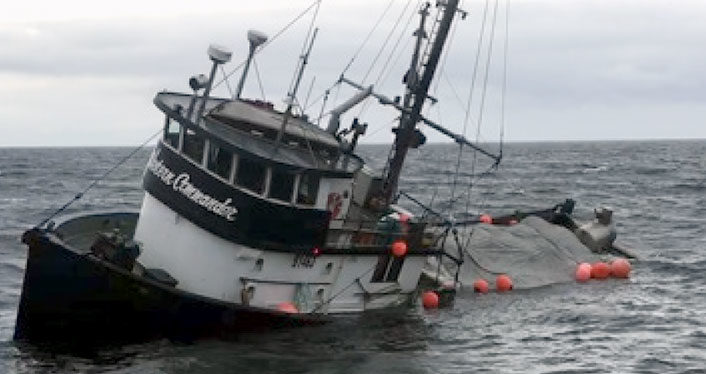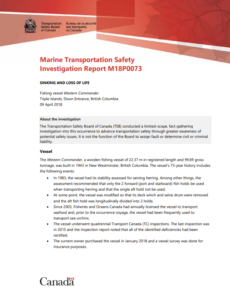The Transportation Safety Board of Canada (TSB) issued an investigation report on the sinking of the fishing vessel ‘Western Commander’ off Triple Islands, Dixon Entrance, British Columbia, in April 2018. The report highlighted issues related to safe loading practices and proper risk identification.
The incident
In April 2018, the vessel was under contract to sea urchin buyers to transport urchins for 11 different harvesters. From 4 April to the morning of 6 April, the vessel remained at anchor in Parry Passage due to inclement weather.
Around 0900 on 9 April, the mate, who was on watch, noticed that the vessel was not fully returning upright when it was heeled over by the swell. Water was coming over the port railing and remaining on deck, and the vessel developed a port list. At some point, water had entered the port forward fish hold. In an attempt to reduce the list, the master started pumping the port forward fish hold and repositioned the boom as far as possible to starboard; however, the list continued to increase.
At 0945, the master made a Mayday call and requested assistance. Shortly afterward, Marine Communication and Traffic Services (MCTS) Prince Rupert broadcast a Mayday relay, and the Canadian Coast Guard (CCG) vessels and the Royal Canadian Marine Search and Rescue 64 vessel were deployed. The master and deckhand left the wheelhouse to locate and don their immersion suits and ready the life raft. The mate remained in the wheelhouse where he attempted to don his immersion suit but, at this time, he experienced a medical emergency.
At 0955, the deckhand returned to the wheelhouse and found the mate incapacitated. The master immediately reported the medical emergency to MCTS. While waiting for assistance to arrive, the deckhand attempted to comfort the mate and monitored vital signs while the master attempted to complete a number of tasks alone. These included communicating with MCTS and the vessel owner, attending to the engine room and pumping duties, monitoring other areas of the vessel for water ingress, and maintaining command of the vessel.
At 1051, the first CCG vessel, the Cape Dauphin, arrived on scene as the Western Commander continued to list to port. The CCG crew stabilized the mate and transferred him to the RCM-SAR 64 vessel, which evacuated him to Prince Rupert at 1120. At 1212, the RCM-SAR 64 vessel arrived in Prince Rupert and transferred the mate to emergency health services. The mate was pronounced dead on arrival at the hospital.
The CCG vessel offered additional pumps; however, the master reported that water was now entering through the galley door and going into the engine room. At this point, the master and deckhand abandoned the Western Commander onto the Cape Dauphin. At 1215, Western Commander sank.
Probable causes
TSB said the factors that potentially affected the vessel’s safe passage included:
- the rudder shaft leak,
- the adverse weather conditions,
- the lack of a damage assessment following the bottom contact, and
- an uneven load distribution.
Given a crew of 3 and the critical timelines required for transporting the sea urchins, it was difficult to maintain an adequate navigational watch and work-rest schedule, which could have affected the vessel’s safe passage.
Lessons learned
- Loading practices
During loading, each of the 11 harvesters that delivered urchins to the Western Commander provided bags of different sizes and shapes at various times over the 2-day period. Some of the bags delivered near the end of this period did not fit through the vessel hatches and were therefore stacked about 1 m high on the hatch covers.
Stacking the bags on the hatches blocked access to the holds and the lazarette and eliminated the possibility of identifying points of water ingress or adding portable pumps to these areas. Stacking bags on top of the hatches also raised the vessel’s centre of gravity and created an opportunity for the cargo to shift, which could adversely affect stability.
It could not be determined how water entered the port forward fish hold or whether the loading practices adversely affected the vessel’s stability to the extent that they contributed to its sinking.
The vessel had a stability booklet for catching and transporting herring, but the stability booklet did not reflect the vessel’s current configuration and operation to transport herring. In this occurrence, given that the vessel was transporting sea urchins, it was not required to have a stability booklet.
Over the past 5 years, the TSB has investigated occurrences involving 21 stability-related fatalities. In most of these cases, the accidents were due in part to the fact that fishing vessel operators did not have information about their vessel’s stability or the stability information was not current.
In response to one of these occurrences, the TSB issued a recommendation calling for Transport Canada to address the issue of inadequate stability information on fishing vessels. TC proposed providing owners with stability notice templates and guidelines along with instructions on how to complete them, and to renew emphasis on stability booklets during inspections.
Loading and securing catch (e.g., sea urchins and herring) should be done in accordance with current vessel-specific stability information to avoid hazards such as uneven weight distribution, cargo shifts, or blocked access to critical areas of the vessel.
- Managing risks
To ensure that a vessel is able to make a safe passage, it is important that vessel owners and crews have safe operating procedures that help identify and address risks. These procedures, which are required by both provincial and federal regulations, can help ensure that crews make sound decisions in any operating condition.
Although the master recognized and took action to reduce some risks (e.g., the potential for weather-related damage to the vessel), this occurrence highlights the need for routine use of safe operating procedures to help identify and address risk in all aspects of the operation, TSB investigation concluded.
Explore more herebelow:































































